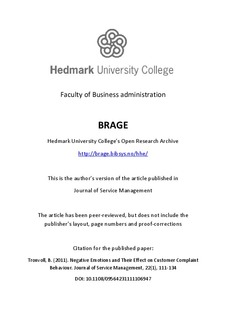Negative emotions and their effect on customer complaint behaviour
Journal article, Peer reviewed
Permanent lenke
http://hdl.handle.net/11250/134306Utgivelsesdato
2011Metadata
Vis full innførselSamlinger
Originalversjon
Tronvoll, B. (2011). Negative emotions and their effect on customer complaint behaviour. Journal of service management, 22(1), 111-134 http://dx.doi.org/10.1108/09564231111106947Sammendrag
Purpose: This study investigates pre-complaint situations and has a threefold purpose: (i) to identify a set of negative emotions experienced in unfavourable service experiences, (ii) to examine the patterns of these negative emotions and (iii) to link these negative emotions to complaint behaviour.
Design/methodology/approach: To fulfil the threefold purpose previously outlined, the study uses a combination of qualitative and quantitative methodologies. A critical incident technique is applied. The empirical data are derived from 25 in-depth interviews and the results of a questionnaire survey of 3104 respondents.
Findings: Twenty observed negative emotions are reduced to a second-order construct with five latent categories of negative emotions: (i) shame, (ii) sadness, (iii) fear, (iv) anger and (v) frustration. These categories coincide with three categories of negative emotions in the agency dimension: (i) other-attributed, (ii) self-attributed and (iii) situational-attributed. The study finds that the negative emotion of frustration is the best predictor for complaint behaviour towards the service provider.
Research limitations/implications: The results are limited by the fact that the data are entirely self-reported. Moreover, the generalisabilty of the results is limited by the fact that the findings relate to one service industry in one country.
Originality/value: The study provides a comprehensive conceptual understanding of both pre-complaint negative emotions and how these emotions affect customer complaint behaviour.
Beskrivelse
This is a postprint version of the article published in Journal of Service Management. You can find the published article here:http://www.emeraldinsight.com/journals.htm?articleid=1911641&show=abstract
